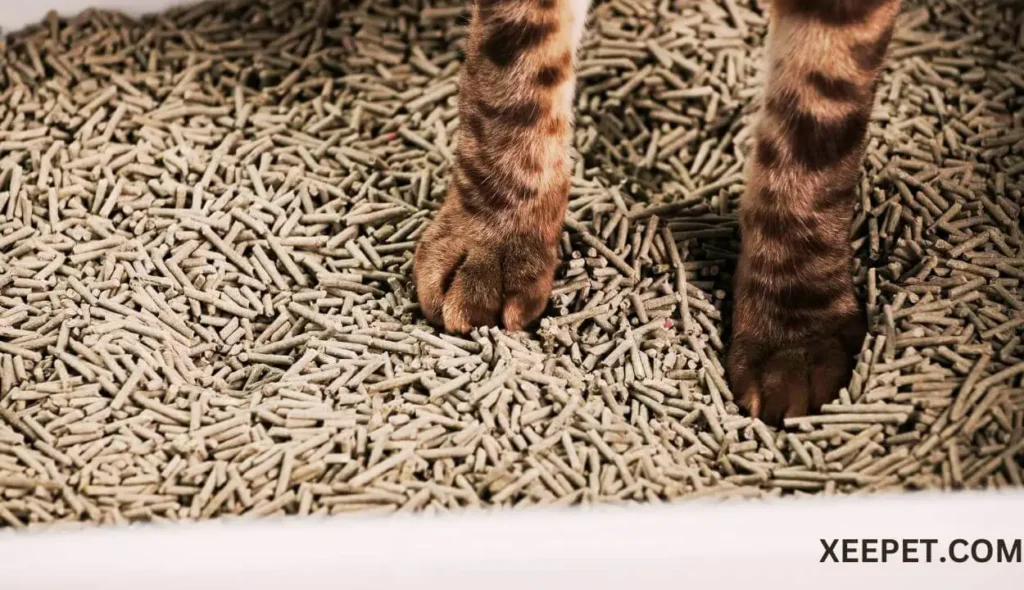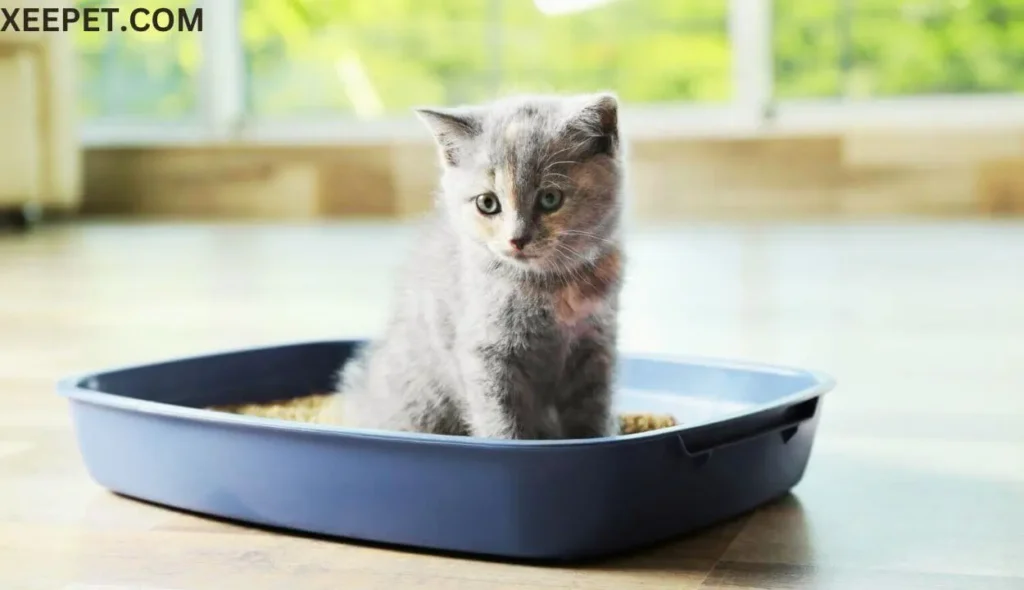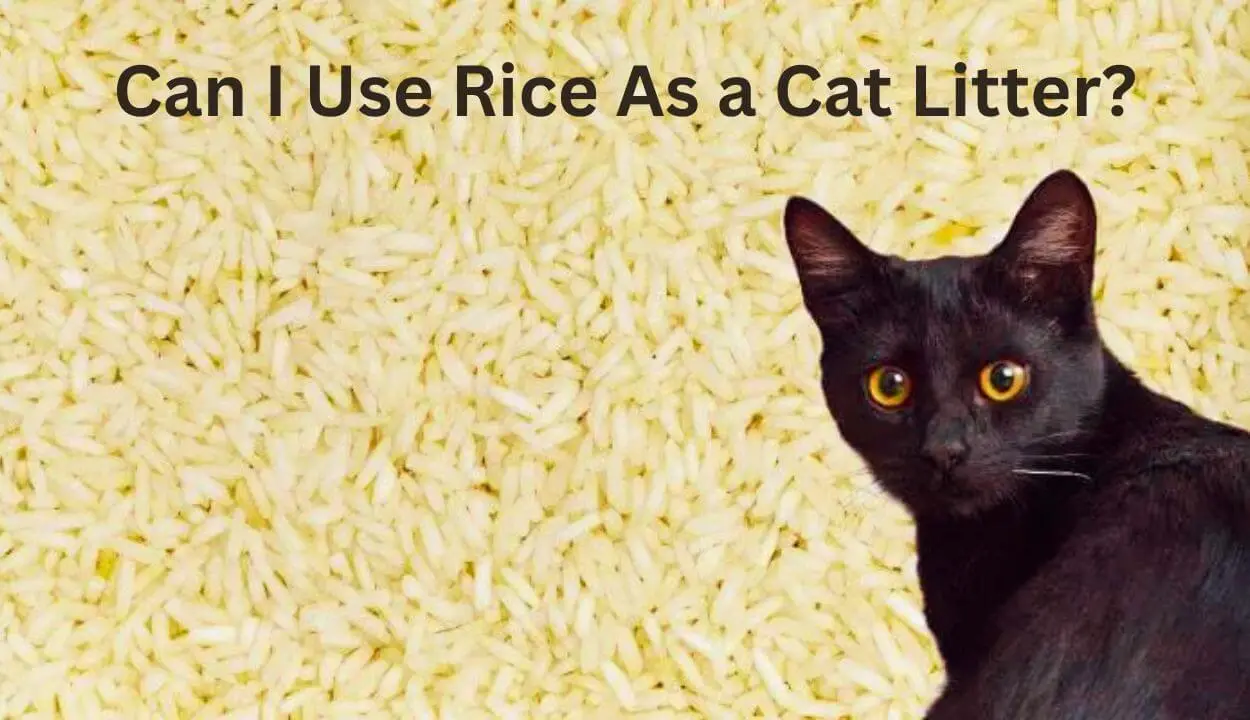Indeed, rice can serve as an emergency substitute for cat litter. It’s a safe, non-toxic option with excellent absorbent properties, making it suitable for soaking urine.
However, while it’s an effective short-term solution, it’s not recommended for long-term use.
Additionally, white rice is preferred over brown or whole wheat rice because it absorbs liquids more easily due to the absence of a husk.
But remember, if you have rice on hand, it might be a better idea to eat it than use it in your cat’s litter box.
So, while rice can certainly step in as a quick fix, it’s always best to stock up on conventional cat litter when possible.
Understanding Cat Litter

Navigating the cat litter world can sometimes feel like a maze, with many types and brands.
Understanding cat litter starts with recognizing what your feline friend needs. Cats prefer a clean, odor-free environment, which is why most litters are designed to be highly absorbent and equipped with odor control.
From traditional clumping clay to more eco-friendly options like recycled paper, wood pellets, or corn, a variety suits your cat’s preferences and household needs. Some litters are dust-free, perfect for cats with respiratory issues, while others are flushable for easy disposal.
The key is to find a balance between what works best for maintaining cleanliness, controlling odors, and keeping your cat comfortable. Remember, any abrupt changes in litter type can upset your cat, so it’s always advisable to transition slowly when introducing a new form of litter.
What is the idea of using rice as cat litter?

Using rice as cat litter may seem unusual, but it’s a topic explored by many curious and innovative pet owners. Rice, known for its absorbent properties, has been considered a potential substitute for traditional cat litter.
The concept hinges on rice-soaking cat urine in a pinch, offering a temporary solution when regular litter is unavailable. However, while it might work in an emergency, rice lacks the odor control and clumping capabilities that standard cat litters provide.
Furthermore, there are potential health risks, such as bacterial growth in wet rice or your cat accidentally ingesting the grains. Therefore, while using rice as cat litter is interesting and worth discussing, sticking with products specifically designed for long-term use is generally recommended.
What are the benefits of using rice as cat litter?
Using rice as cat litter can have several benefits:
- High Absorbency: Rice is known for its absorbent properties, making it capable of soaking up cat urine efficiently. This can be particularly useful in emergencies when traditional cat litter isn’t available.
- Eco-Friendly: Rice is more eco-friendly than many commercial cat litter as a natural, biodegradable material. It reduces landfill waste and doesn’t involve environmentally damaging processes like mining, which is often the case with clay-based litter.
- Non-Toxic: Rice poses no risk of exposing your cat to potentially harmful chemicals that might be found in some commercial litters. This makes it a safe, though temporary, alternative.
- Dust-Free: For cats with allergies or sensitivities to dust, rice offers a dust-free alternative, potentially reducing respiratory issues.
- Cost-Effective: Depending on where you live, rice can be a cheaper alternative to commercial cat litter, especially the specialty types.
Alternatives to Rice and Traditional Cat Litters
Many options are available if you are looking for alternatives to rice and traditional cat litter. Some of the best substitutes come from the food industry and include:
Wood Pellets:
- Eco-Friendly: Wood pellets are made from recycled sawdust or lumber mill scraps, reducing waste and contributing to a greener planet.
- Odor Control: These pellets’ natural pine or cedar scent helps control unpleasant odors, keeping your home smelling fresh.
- Cost-Effective: Generally, wood pellets are quite affordable, making them a good choice for budget-conscious cat owners.
Corn-Based Litter:
- Biodegradable: Corn-based litter decomposes naturally over time, making it an environmentally friendly option.
- Clumping Properties: Unlike rice, corn litter forms clumps when wet, making cleaning the litter box more straightforward.
- Flushable: Many corn-based litters can flush down the toilet safely, providing a convenient disposal method.
Paper-Based Litters:
- Dust-Free: Made from recycled paper, this litter is excellent for cats with respiratory issues as it doesn’t produce dust.
- Absorbency: Paper-based litters have high absorbency rates, soaking up cat urine and keeping the litter box dry.
- Lightweight: Paper-based litters are often lighter than other types, making them easier to handle and transport.
Walnut Shell Litter:
- High Absorbency: Walnut shell litters are known for their superior absorbency, effectively soaking up liquids and helping to maintain a clean litter box.
- Odor Control: These litters offer excellent odor control due to their natural ability to neutralize smells, keeping the litter box and surrounding area smelling fresh.
- Natural and Safe: As walnut shell litter is made from natural materials, it’s a safe option for your cat and the environment.
Silica Gel Litters:
- Moisture Absorption: Silica gel litters, made from tiny, porous granules, can absorb a significant amount of moisture, keeping the litter box dry for longer periods.
- Odor Control: This litter also effectively controls odors by locking them inside the silica crystals.
- Long-Lasting: Silica gel litters are known for their longevity, requiring less frequent changes than many other types of litter.
Grass Seed Litter:
- Biodegradable: Grass seed litter is another eco-friendly option that decomposes naturally over time.
- Dust-Free: Like paper-based litter, grass seed litter doesn’t produce dust, making it suitable for cats with respiratory issues.
- Soft Texture: The soft texture of grass seed litter is gentle on cat paws, making it comfortable for cats.
Wheat-Based Litter:
- Clumping and Flushable: Wheat-based litter forms clumps when wet and is generally safe to flush, offering convenience in cleaning and disposal.
- Odor Control: Wheat has natural enzymes that help control odors, creating a fresher-smelling home.
- Eco-Friendly: As it’s made from a renewable resource, wheat-based litter is an environmentally conscious choice.
Coconut Husk Litter:
- High Absorbency: Coconut husk, or coir, has a high absorbency rate, effectively soaking up cat urine.
- Biodegradable: This type of litter is biodegradable and compostable, making it an eco-friendly option.
- Lightweight: Coconut husk litter is lightweight, making it easy to handle and transport.
Pine Cobble Litter:
- Natural and Safe: Pine cobble litter is made from 100% natural pine, offering a safe and non-toxic option for your cat.
- Odor Control: The natural pine scent helps to neutralize odors, keeping the litter box smelling fresh.
- Dust-Free: Pine cobble litter produces little dust, making it a good choice for cats with respiratory sensitivities.
Tofu Litter:
- Biodegradable and Flushable: Made from tofu, this type of litter is biodegradable and can be flushed down the toilet.
- Odor Control: Tofu litter has excellent odor control properties, helping to keep your home smelling clean.
- Soft Texture: The soft texture of tofu litter is gentle on cat paws, providing a comfortable surface for your cat.
When choosing a cat litter, make sure that it is easy to clean. if this is not done, that cat will develop a variety of smell like maple syrup.
Can I Use Soil As Cat Litter
If you are wondering whether you can use soil as cat litter, the answer is yes, you can. But it’s not always the best choice. While soil is a natural and cheap option, your cat might not like it.
Some cats avoid using soil in their litter boxes. Plus, soil, especially potting mix, can have bacteria and fungi, which aren’t good for your cat. Also, soil tracking around your house can be messy more than regular cat litter.
Other options, like sand, don’t have additives or chemicals in some cat litter. So, while you can use soil as cat litter, it might not be the most convenient or preferred choice for your furry friend.
Can I Use Sand As Cat Litter
Yes, you can use sand as cat litter. It’s a natural product with no added chemicals, as some cat litter does. Cats usually like it, and it’s safe for them to use.
However, there are a few things to keep in mind. Sand can be messy and might track around your house. Also, if you are using regular sand, it might contain harmful bacteria or parasites.
So, while sand can be an affordable and environmentally friendly alternative to commercial cat litter, it’s important to use clean sand and be prepared for a bit more cleanup.
Can I Use Flour As Cat Litter
Using flour as cat litter is a good idea because it’s soft on cat paws. There are a few considerations, though. Some sources say it’s not the best choice because regular flour can have industrial residues.
Also, flour can become sticky and hard to clean when wet. If your kitty eats the flour, that could be another problem. But don’t worry; there are other homemade options you can try.
You can use wheat, wood chips, or even baking powder. So, while flour might not be the best option for cat litter, you can explore many other eco-friendly and cheap alternatives.
Conclusion
Based on a comprehensive review of various sources, rice can be a viable substitute for cat litter in emergencies. Its high absorbency makes it particularly effective at soaking up urine.
Importantly, rice is non-toxic and safe for cats, posing no immediate health risks. However, it’s critical to note that this should be a temporary solution.
While white rice, lacking the husk, absorbs liquids more easily than brown or whole-grain varieties, it’s not recommended for prolonged use.
FAQs Of Can I Use Rice As A Cat Litter
If I don’t have a litter box, what can I use?
If you don’t have a litter box, you can use alternatives like a cardboard box lined with a plastic bag filled with cat litter. Other options include using a disposable aluminum baking pan or shredded newspaper in a pinch.
How to make cheap cat litter?
You can use shredded newspaper or wood shavings to make cheap cat litter. Here’s a simple method using a newspaper:
1. Shred newspaper into strips.
2. Soak the strips in warm water mixed with dish soap until it’s pulpy.1.
3. Rinse and drain the pulp.
4. Spread it out to dry completely.
5. Once dry, put it in a litter box.
Can I use rice hull as cat litter?
Yes, you can use rice hulls as cat litter. They are biodegradable and excellent at absorbing moisture and controlling odors. However, they don’t clump like traditional cat litter, so you’ll need to clean the litter box more frequently. Use unprocessed rice hulls to avoid any potential chemicals or additives.




